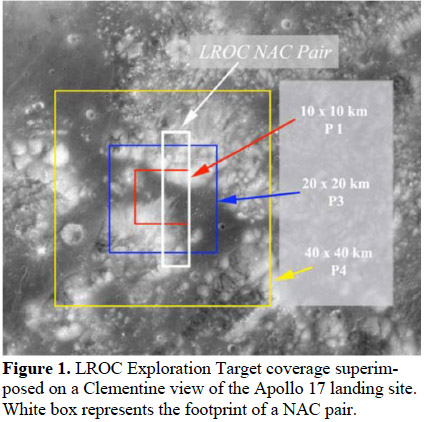Cx35
Contents
[hide]Constellation Program Regions of Interest for Human Exploration
Description
NASA is interested in these Regions of Interest (RoI) as possible exploration sites when we return to the Moon as part of the Constellation Program (CxP). I propose that for each of the sites visible from Earth that a data collection page be established, much as this wiki does for each named feature, but in more detail. For example, NASA is imaging a 40 x 40 km square to provide context for the details seen in 20 x 20 km and 10 x 10 km nested areas. Amateurs can provide excellent wider scale context by collecting images of, say 250 x 250 km and 100 x 100 km squares under various lighting conditions. Amateurs can find and link to fundamental professional publications (and LPODs!) for each of these areas. Many more types of information can be added, and wikis provide the flexibility to do so. More will come here soon, and then over the next years.
Note that each of these targets is just a small area within a larger feature - we typically cannot just use the existing Moon Wiki page for these RoI's. Note also that a new manned landing on the Moon by NASA is still a long way off and much new knowledge about the Moon will be gained by then. Although the present list of intensively studied RoI's is "representative" of the areas where manned exploration might take place, the eventual landings could be elsewhere.
Thanks for your visits and contributions!
- tychocrater Jan 8, 2010

Illustration of coverage of RoI squares and nominal NAC dual images footprint.
From B. L. Jolliff et al. (2009)
Tier 1 Nearside Targets
 <-- click to see locations of Tier 1 RoI's (the background image is the Kaguya grayscale DEM)
<-- click to see locations of Tier 1 RoI's (the background image is the Kaguya grayscale DEM)
| Feature Name |
Long |
Lat |
| -2.16 |
-12.56 | |
| -9.30 |
73.48 | |
| 3.66 |
26.08 | |
| 15.47 |
-9.00 | |
| -48.95 |
24.56 | |
| -52.40 |
27.70 | |
| -22.50 |
-20.70 | |
| -20.01 |
9.85 | |
| -40.14 |
36.03 | |
| -2.93 |
-85.99 | |
| 58.84 |
10.68 | |
| -0.42 |
4.74 | |
| North Pole |
76.19 |
89.60 |
| Orientale 1 |
-95.38 |
-26.20 |
| Peary Crater |
30.00 |
88.50 |
| -3.80 |
12.90 | |
| South Pole |
-130.00 |
-89.30 |
| 10.37 |
19.87 | |
| -11.20 |
-42.99 |
Italics = in libration zone, visible from Earth only with favorable librations
- (Orientale 1 is slightly beyond the limb at mean libration)
Tier 2 Nearside Targets
 <-- click to see locations of Tier 1 RoI's (the background image is the Kaguya grayscale DEM)
<-- click to see locations of Tier 1 RoI's (the background image is the Kaguya grayscale DEM)
| Feature Name |
Long |
Lat |
| 69.82 |
-18.69 | |
| Compton/Belkovich Th Anomaly |
99.45 |
61.11 |
| -43.22 |
-2.45 | |
| -27.67 |
7.48 | |
| 77.14 |
54.54 | |
| 5.29 |
18.65 | |
| -67.23 |
31.65 | |
| 26.10 |
59.80 | |
| Mare Smythii |
85.33 |
2.15 |
| 22.06 |
6.93 | |
| -55.80 |
13.58 | |
| Mendel-Rydberg Cryptomare |
-93.07 |
-51.14 |
| 40.81 |
-15.91 | |
| Orientale 2 |
-87.91 |
-18.04 |
| -5.21 |
53.37 | |
| -58.56 |
7.53 | |
| -74.28 |
-3.04 | |
| -41.72 |
27.41 |
Italics = in libration zone, visible from Earth only with favorable librations
- (the Compton/Belkovich Th Anomaly and the Mendel-Rydberg Cryptomare are slightly beyond the limb at mean libration)
Farside ROI's
(these Regions of Interest are never visible from Earth)
Tier 1
ROI - Aitken Crater
ROI - Apollo Basin
ROI - Hertzsprung
ROI - King Crater
ROI - South Pole-Aitken Basin Interior
ROI - Stratton
Tier 2
ROI - Dante Crater
ROI - Ingenii
ROI - Mare Moscoviense
ROI - Schrödinger
ROI - South Pole-Aitken Rim
ROI - Tsiolkovsky Crater
ROI - Van De Graaf Crater
Additional Information
- According to Lucey et al. (2009: The regions of interest were selected based on three criteria:
1. Science rationale - the 50 sites are of unique scientific interest or are scientifically complex requiring intensive field work with human interaction.
2. Resource potential - as a whole, the 50 sites are representative of the type of natural resources available for development and exploitation.
3. Operational perspective - as a whole, the 50 sites are representative of the different terrain types that the Altair lunar lander and the various lunar surface systems may encounter. - The Constellation Regions of Interest are available as dot files for plotting with the LTVT software (see sample LTVT-produced nearside finder images, above), as is the much larger list of targets of scientific interest being explored with the Lunar Reconnaissance Orbiter Cameras.
LPOD Articles
Bibliography
- Lucey, P. G. et al. (2009) LEAG Review of Constellation Program Regions of Interest for Human Exploration of the Moon. Lunar Reconnaissance Orbiter Science Targeting Meeting, held June 9-11, 2009 in Tempe, Arizona. LPI Contribution No. 1483, p.73-74
- Jolliff, B. L. et al. (2009) Targeting the Lunar Reconnaissance Orbiter Narrow Angle Cameras: Target sources and selection strategy. 40th Lunar and Planetary Science Conference, (Lunar and Planetary Science XL), held March 23-27, 2009 in The Woodlands, Texas, id.2343
- NASA's PDF list of Tier 1 sites
- NASA's PDF list of Tier 2 sites